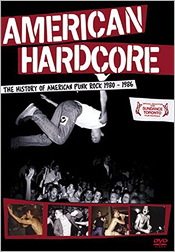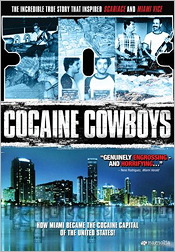 |
Site created 12/15/97.

page created: 2/20/07
 Get Real - A Totally 80s Documentary Double Feature Adam Jahnke - Main Page |
| Time
to venture into the untamed world of non-fiction film again, folks.
This time out, both movies are about roughly the same time period,
the early-to-mid 1980s. But the scenes they cover are night-and-day
different, proving there was a lot more to the 80s than valley girls
and aerobics. |
| The
problem with most docs that try to cover the punk scene is the
substantial difference between the UK punks and their American
counterparts. Like its title suggests, American
Hardcore by and large ignores British bands like the Sex
Pistols, except to give a nodding reference to their influence and,
more importantly, to show how the American punks tried to
distinguish themselves from what was happening overseas. The movie
also does a good job differentiating between the scenes in different
cities, showing how the L.A. punks, for instance, influenced what
was happening in D.C., which in turn influenced Boston and on and
on. It paints a picture of an underground network of bands,
promoters and roadies with all the rivalries and alliances such an
organization would generate. Rachman and author Steven Blush (whose book inspired the film) interview dozens of punk veterans, punctuated by great photographs and footage of bands like Bad Brains, Black Flag and SSD. The aggression and energy of the music is matched by the design work of John Vondracek. The interviewees, including Ian MacKaye of Minor Threat, Jack Grisham of T.S.O.L. and the ubiquitous Henry Rollins, are by and large great storytellers, providing some terrific anecdotes and insight into not only how the punk movement formed and was spread but why it flamed out so quickly. Even if you hate punk rock, you'll come away from this admiring these guys (and yes, while there are a handful of women here, it's a mostly male lineup). The punk movement is one of the few in modern music to have erupted spontaneously for nothing more than the joy of doing it. Certainly none of these guys harbored any illusions that they'd get rich playing this kind of music. This is rare in any field and all but unheard of in the music industry. Naturally there are some gaps here but that's to be expected in any movie that tries to cover this much ground. True hardcore fans will argue for hours about the bands that were left out. You could also argue that the movie ends too definitively, with pretty much everyone agreeing that by 1986, punk was dead. This may or may not be true. Certainly its influence lived on. What's important is that for the people profiled in this film, it was true. It was over and anything that came afterward had nothing to do with what they were about. Sony's DVD of American Hardcore is pretty spiffy for a standard issue disc. The video and audio qualities are as good as possible, considering how much of the film is made up of footage shot in the 80s on consumer-grade video and Super 8 with in-camera sound. Extras include 50 minutes of deleted scenes, a brief featurette called In The Pit spotlighting the photography of Ed Colver, and, best of all, six complete musical performances excerpted in the film. Sure, the songs are lightning-fast but it's terrific to see footage of Jerry's Kids, YDI, Void, SSD, Bad Brains and Millions of Dead Cops in all their original camcordery glory. There's also footage of DOA and the Circle Jerks playing at the Sundance premiere party. They're still great but nowhere is the difference between then and now more obvious. Instead of the band's spray-painted name, the back wall of the stage is covered by a banner for corporate sponsor Vans. How punk. Finally, Rachman and Blush contribute a less-than-inspired audio commentary, mostly of interest if you want to know where they shot their interviews although they do touch on why bands like the Misfits and the Dead Kennedys were left out. As an introduction or a refresher course in punk history, American Hardcore does its job with style and energy. Docs on specific bands obviously can go into more detail and there's still room to explore the subject by focusing on individual cities and their unique styles. American Hardcore, on the other hand, casts its net wider and helps connect the dots on the map. Program Rating: B Disc Ratings (Video/Audio/Extras): B/B-/B |
| Eventually
we enter the supply side, meeting hitman Jorge "Rivi"
Ayala. Rivi, who is interviewed from the prison where he'll
presumably be spending the rest of his life, remains a charismatic
figure. His descriptions of the vicious murders he helped carry out
on the orders of "Godmother" Griselda Blanco are chilling
in their matter-of-fact, no-regrets tone. Corben interviews the good
guys too, including retired homicide detective Al Singleton and
reporters Edna Buchanan and Al Sunshine. Their comments are welcome
but the meat of the story comes straight from the horse's mouth. The hyperactive style of Cocaine Cowboys almost makes this a documentary for people who hate documentaries. The flip side of this, of course, is that if you love them, you might hate this, accusing it of all flash and no fire. There might be some truth to that but the style is dictated by the story being told. Nothing's worse than a doc that takes an exciting story and renders it lifeless. If nothing else, Cocaine Cowboys certainly can't be accused of that. Propelled by a driving score by Jan Hammer, Mr. Miami Vice himself, you'll be amazed at how quickly Cocaine Cowboys' nearly two hour running time flies by. Magnolia has done a nice job with this disc, giving it a decent anamorphic transfer and a 5.1 audio track. The extras are almost as compelling as the film, starting with a 15-minute mini-movie called Hustlin' with the Godmother: The Charles Cosby Story, a bizarre coda to the already strange story of Griselda Blanco. Fourteen deleted scenes are included with more details about Mickey Munday's drug trafficking operations, Rivi's hits, and amusing but non-essential stories. Finally Corben and co-producer/co-editor David Cypkin provide commentaries on the film and all the extras. Their voice-overs are nearly as fast-paced as the movie itself. I'll admit I knew next to nothing about this subject before watching Cocaine Cowboys and that may be the best way to approach the film. If you're already familiar with what was happening in Miami back then, this may be old news that doesn't tell you anything you didn't already know. Even so, it tells it well, making Cocaine Cowboys a blast for lovers of true crime sagas. Program Rating: A- Disc Ratings (Video/Audio/Extras): B+/B/B On Anna Nicole... Bad news travels fast they say and these days, it moves quicker than ever. Last week, I was sitting at my computer and saw a news story on Yahoo with the headline "Anna Nicole Smith rushed to Florida hospital after collapse". I clicked on it and by the time the new page finished loading, it had changed to "Anna Nicole Smith dies". Anna Nicole Smith, model, Playboy Playmate and reality TV star, was something of a national joke for a number of years. Between her tabloid appearances and her outlandish public persona, stoked in no small part by The Anna Nicole Show on E!, she was, too put it kindly, an easy target. But it was a joke that she seemed to be in on. Certainly she must have known that eyebrows would be raised when she married an oil tycoon over fifty years her senior. Or perhaps she didn't. Maybe she really was as naïve as she often appeared on television. Either way, she clearly had a sense of humor about herself and her image and this is not a character trait to be dismissed lightly. Anna Nicole had a film career as well, though it might charitably be referred to as "checkered". Most forget that her movie debut was in the Coen brothers' 1994 screwball comedy The Hudsucker Proxy. That was followed by a larger role in The Naked Gun 33 1/3: The Final Insult. One of her few leading roles was as a helicopter pilot in the direct-to-video erotic action thriller Skyscraper, a Die Hard clone with Anna Nicole in the Bruce Willis role. It's basically what you might expect from a film with that description. My wife worked with Anna Nicole Smith on a movie called Wasabi Tuna a few years back. The impression I got from the on-set stories I heard was that she was a sweet, intelligent woman fully aware and in control of the image she was projecting to the world. Unfortunately, her life story always had an air of sadness to it. From the legal battles over her late husband's estate to the sudden death of her son just days after the birth of her baby daughter, it often seemed as if she just couldn't catch a break. Now her story has ended at a young age, just as it did with Marilyn Monroe, someone she clearly idolized. Without Anna Nicole Smith, somehow the world now seems a little less voluptuous. Adam Jahnke ajahnke@thedigitalbits.com |
Adam Jahnke - Main Page
 |
| Site
designed for 1024 x 768 resolution, using 16M colors and .gif 89a
animation. © 1997-2015 The Digital Bits, Inc., All Rights Reserved. billhunt@thedigitalbits.com |

